It was as I walked down San Francisco ’s Market St with my family on
August 10 that I spotted a scene I’d previously witnessed only in TV shows such
as The Wire. Two policemen were
running towards us, guns drawn. As I started shepherding the family out of the potential
line of fire, I spotted the reason for the fracas. A young-ish black man was
sprinting towards us. He threw a large, plastic wrapped parcel over a wooden
hoarding then, having ditched the evidence, surrendered himself. We continued
our stroll as he knelt on the sidewalk, face towards a building, with the
police officers handcuffing his hands behind his back.
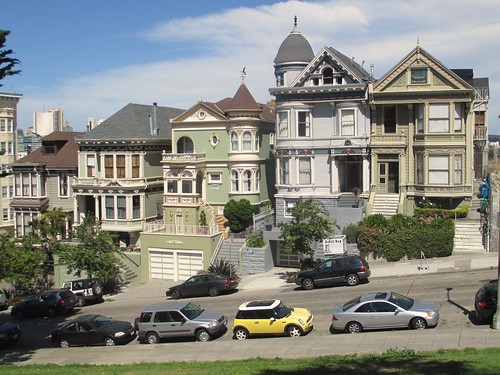 |
| San Francisco's Painted Ladies: the epitome of Victorian respectability - and only a short walk from where our family encountered a street drugs bust. |
I didn’t know it at the time but, the previous evening, half
a continent away, a confrontation between a young black man and white police
officers had ended tragically differently. In Ferguson , Missouri
The scene in San Francisco ran
through my head over the next few days as we saw, despite our holiday
isolation, pictures of police in Ferguson
equipped for war but facing mainly peaceful protesters. I also found myself
making mental links between the scene we’d encountered and a far less grave
injustice that was closer to home for me – the New York Police Department’s disproportionately
harsh Operation Cyclesafe crackdown on cyclists’ rule-breaking.
The street drugs bust, the events in Ferguson and the NYPD’s harassment of
cyclists all look to me to be the work of police forces more concerned about asserting
their own authority than actually making the places they police safer. It’s
hard in light of these and other incidents to avoid the conclusion that many US police
forces are currently bereft of ideas and moral sense. While UK police forces rethought some aspects of their
policing 30 years ago after urban rioting, the Metropolitan Police’s recent
purchase of a water cannon hints that such thinking is creeping back in the UK too.
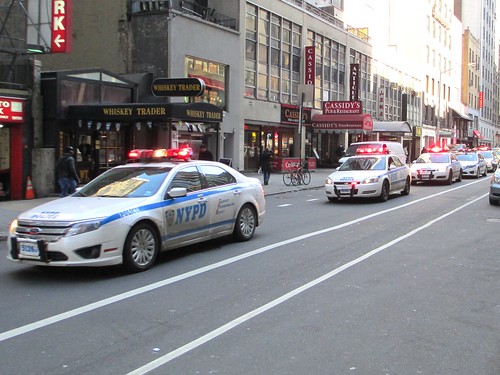 |
| NYPD cruisers: sensitive, intelligence-led policing |
I wouldn’t say I was precisely naïve about the potential
misuse of police power, even before recent events. In one obviously
conflict-ridden society, Bosnia ,
I remember seeing Bosnian Croat police harassing the mainly Bosniak – Bosnian
Muslim – passengers on a bus where I was travelling in 1995 during the Bosnian
war. Hungary ’s
police seldom impressed me when I lived there.
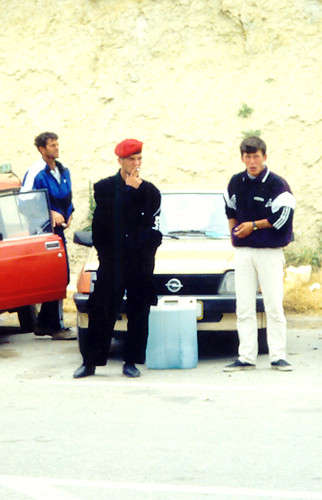 |
| A Kosovo Liberation Army "policeman" smokes while supervising sales of smuggled fuel: just one of many less-than-impressive officers I've encountered during more than two decades' reporting. |
I have a particularly vivid memory from my home country of
watching the reaction of Northern Ireland’s Royal Ulster Constabulary in July
1996 to rioting by members of the mainly Irish Nationalist Catholic community
on the outskirts of Portadown, in the centre of the province. For five days
previously, the police – mainly pro-British Protestants – had reacted with
remarkable restraint as Protestants rioted over the routing of a march by the
Protestant Orange Order in Portadown. After the police finally forced the march
down Garvaghy Road ,
against the mainly Catholic residents’ wishes, I watched the police fire rubber
bullets freely. At one point, I saw people of all ages, violent and non-violent
alike, flee into a narrow passageway between shops. The police pumped plastic
bullets indiscriminately into the passageway, knowing they would hit rioters
and non-rioters.
My personal experiences as a cyclist have made me realise
that bad policing affects places other than obviously conflict-ridden societies
and people other than clearly discriminated-against minority groups. I’ve been
lectured by City of London Police officers who were themselves breaking the road rules about my allegedly
irresponsible behaviour. In May, I encountered a man who claimed – to my
satisfaction – to be an off-duty cop. He grew verbally abusive when I asked
him to move his car out of a busy, two-way cycle lane. There are stretches of
road in New York
where I know I’m likely to encounter police cars or vans illegally parked in the cycle lane and to have to dodge around them.
Yet I had retained, I now recognise, a residue of rather
British innocence about democratic countries’ police forces, a feeling that
they must somehow be on the side of the law-abiding, no matter their colour or
background, against those who would harm them. I remember the times my parents
had to call on the police when I was young and their polite attitude when they
visited our large, respectable house.
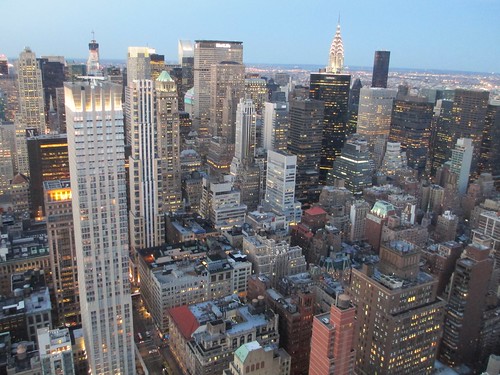 |
| Broken windows might have helped to make it safe for me to walk nearly anywhere in this picture - it hasn't necessarily done the same for people with darker skin. |
Recent events have washed that residue out of me. I
increasingly recognise how it was my family’s whiteness and respectability that
won the police’s politeness. If I were black or belonged to some other
obviously marginalised group, I would have far more – and probably far worse –
stories about police behaviour. I’m more and more sceptical of the policing
philosophy that’s come to dominate much of the western world in recent years –
the idea that police intolerance of minor misdemeanours is critical to tackling
crime overall. Bill Bratton, the police commissioner who returned to the top post in the NYPD earlier this year, pioneered this “broken windows” approach in
New York City .
Its apparent success in making the city safe again in the 1990s has led to its
widespread acceptance as a policing approach elsewhere.
It’s to some extent because of broken windows that officers
felt justified, I suspect, in violently restraining Eric Garner while arresting
him for the minor crime of selling untaxed cigarettes. It’s because police
officers are encouraged to create an orderly atmosphere on the streets, I
suspect, that officer Darren Wilson thought it important to confront Michael
Brown and his friends about where they walked. It’s a sense that street
drug-dealing is worse than more discreet drug-dealing that leads to scenes like
the one we encountered in San Francisco. I’ve long had a strong sense that the
broken windows approach explained the NYPD’s tendency to give disproportionate
numbers of traffic tickets to cyclists. If one believes that a police force’s
main goal is to tackle the problems that create most noise at public meetings,
it might well make sense to run a two-week crackdown on dangerous cycling.
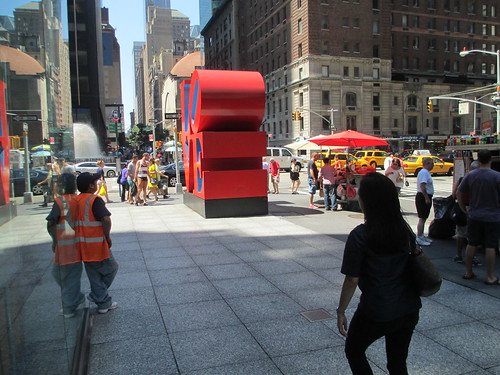 |
| Midtown Manhattan: a bad place to break a window, thanks to Bill Bratton, but not a bad place, necessarily, to commit a serious fraud |
The approach’s limitations are clear as soon as one starts
examining them. Any strategy that deliberately devotes disproportionate
resources to small, “quality-of-life” offences by its nature takes resources
away from investigating the crimes – racketeering, murder, rape, fraud – for
which society imposes the harshest penalties. The approach quickly degenerates
into an anti-intellectual tendency to go after the crimes whose victims make
the loudest noise, rather than those that are the biggest problem. It’s obvious
that the arrest of one street-level dealer is unlikely to do anything to
eradicate demand for illegal drugs in San
Francisco or the business of supplying them.
Some good might yet come out of the grim events in Ferguson
and elsewhere in the US this summer if they prompt a thorough re-examination of
how the US is policed – a change that would surely have repercussions in other
countries too. It would be heartening to see police forces question whether the
constant harassment of the poorest groups under broken windows makes sense.
There is surely scope to ponder which offences cause the most overall harm and
start to tackle them.
I’ve argued before that traffic policing would be far better
if commanding officers’ pay depended partly on the numbers of people injured on
their areas’ streets, rather than the numbers of tickets handed out. A police
force focused on preventing crime rather than enforcing order would surely not
have thought a confrontation over where a group of young men walked worth provoking.
Intelligent traffic policing might even seek to encourage cycling, recognising
that cyclists are far less likely to kill other road users than motorists are.
It’s hard to be optimistic that such changes are coming
soon, however. Reaction to the events in Ferguson
has followed a pattern all too familiar in the contemporary US – right-wingers
have defended the police, while the left have criticised them. On Twitter last
week, Bill Bratton wrote that he was “gratified but not surprised” that New
Yorkers appreciated “quality of life enforcement measures”. I’ve seen even cyclists
welcome Operation Cyclesafe’s misdirection of resources, saying that, since
they never break the rules, they have nothing to fear from it. Few people seem
to recognise how crackdowns on minor crime misdirect resources.
Two experiences on our return from California crystallised the nature of the
problem. I returned to my regular cycle commute in the last days of Operation
Cyclesafe to find that the crackdown had unsurprisingly done nothing to make
the streets safer for cyclists. The cycle lanes appeared still more regularly
blocked than normal and drivers’ behaviour still worse than normal.
The Invisible Visible Woman, meanwhile, heard two women
discussing Eric Garner’s death on the street. It’s hard to avoid the conclusion
that broken windows policing has turned some police forces into vehicles for
the kinds of prejudice our neighbours were expressing.
“People say they heard him say, ‘I can’t breathe’,” one of
them commented to the other, who nodded sagely. “But you have to remember –
this was a man who’d been to prison ten times.”
An uncritical readiness to go after the offences that most
annoy people quickly degenerates into a readiness to go after the people that
most annoy the majority. That will sometimes be cyclists. It will far more
often – and with far more deadly outcomes – be poor people like Eric Garner, condemned by prejudice to miserable and public deaths.

On a positive note, recent events have caused the current administration to reconsider the wisdom of delivering armored vehicles to rural police agencies such as the one recently delivered to Pacific County, WA. What next? Attack helicopters?
ReplyDeleteSteve A,
DeleteYou're right it's a good thing if the mad programme of sales of armoured vehicles to police forces ends. It would be nice if the mentality that made the police think they needed the vehicles died along with the programme.
All the best,
Invisible.
I think the rationale of the recipients is pretty easy to understand - "cool and free." From there, justifications are created. For example, Pacific County cited a recent standoff in an RV Park as a case where the MRAP would guarantee officer safety, forgetting that distance would accomplish the same objective.
DeleteSteve,
DeleteThere was an incident near my apartment a while ago where the police shot dead an emotionally-disturbed man who had stabbed his uncle, with whom he shared an apartment. The stabbing was sufficiently undramatic that the uncle needed no hospital treatment - yet they pumped seven bullets into the poor, mentally ill young man. There is consistent exaggeration of the risks that police officers face and a consistent downplaying of the risks and moral issues related to officers' deployment of force. If armoured vehicles make it easier for police forces to deploy armed force with impunity, it can only be a bad thing.
I hope Pacific County's MRAP gathers dust and is then scrapped.
All the best,
Invisible.
"I hope Pacific County's MRAP gathers dust and is then scrapped." We can only hope and pray - for the moment. Hopefully, someone will come to account someday. Just because the Feds offer something ridiculous is no excuse for people to completely abandon common sense...I hope Pacific County's MRAP gathers dust and is then scrapped.
DeleteSteve,
DeleteI guess one point in all this is that police forces feel, like many parts of the US public sector, that they don't have enough resources to do the job. So free stuff becomes that bit more attractive.
One issue in Ferguson seems to have been that a very high proportion of the city's revenue came from fines for misdemeanours - and a very high proportion of the spending was on the police. There's often a very unhealthy relationship between the police and any given municipality's financial imperatives.
At least in your damp air up there, the MRAP should rust fairly fast.
All the best,
Invisible.
I don't know if there is clear proof of the "broken windows" approach reducing the crime rate in NY as apparently the crime rate also reduced in other US cities at the same time, and they had a different approach to policing.
ReplyDeleteThere is a (controversial) theory that the reduction of crime rate in the 1990s was a consequence of the legalisation of abortion in the 1970s.
http://freakonomics.com/2005/05/15/abortion-and-crime-who-should-you-believe/
Michael,
DeleteI've heard theories about crime reduction related both to abortion and the eradication of lead in drinking water. The common factor in all of them is that the fall in crime associated with broken windows might well have happened in any case. It's certainly time to re-examine how well the concept is working in a world facing very different challenges from those of 1989.
All the best,
Invisible.